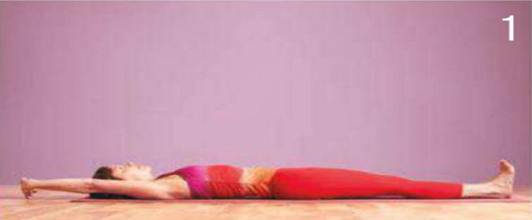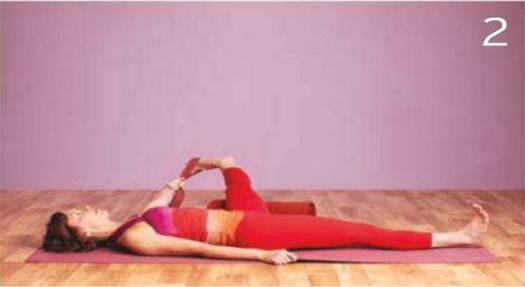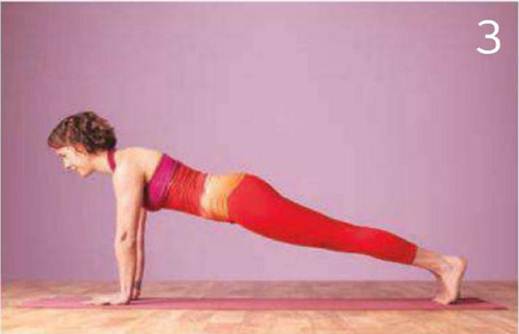Supta tadasana - Reclining Mountain
Pose, variation
This supine position, Supta Tadasana will
make it easy to feel the natural curve of your lumbar spine (low back), the
lengthening through your torso and limbs, and the engagement in your core.
Slide your thumbs underneath your buttocks toward your feet to relieve any
overarching in the lumbar spine. At the same time, avoid pressing the low back
into the floor. You want to maintain the natural curve of the spine. Flex your
feet and extend from your buttocks through your heels.

Reclining
Mountain Pose, variation
On an exhalation, soften your temples and
relax your jaw to encourage a feeling ò relaxation throughout the body. Exhale
a little more deeply until the muscles around your belly firm in toward the
navel and down toward the lower back. Hold the sides of the mat and roll the
outer edges of your upper arms toward the floor to externally rotate your upper
arms so that your chest broadens. As you hold the mat, release the trapezius
muscle (near the base of the neck) away from your ears.
Lift your arms and interlace your fingers
with your palms facing the ceiling. Draw the inner arms down toward the
shoulder joint until the arm bone sits firmly in the socket. Exhale deeply
until the belly engages, and then slowly start to extend your arms overhead.
Extend through the full length of the body for up to a minute here, breathing
mindfully. Then release your arms by your side.
Supta Padangusthasana II - Reclining
hand-to-Big-Toe Pose II.

Reclining
hand-to-Big-Toe Pose II
Anantasana requires that you externally
rotate and extend the top leg-not an easy movement to master while balancing on
your side. In order to do this without losing your balance, you’ll use a
blanket to prop your leg that extends to the side in order to learn how to
isolate the actions of the hip while you keep the rest of your body steady and
stable.
Place a firm blanket roll alongside your
upper left thigh and pelvis. Bend your left knee, wrap a strap around your foot
near the base of your toes, and extend your left leg toward the ceiling. Take
your right hand and hold the outer edge of your mat. Externally rotate your
right arm while keeping a neutral spine and maintaining length through the
right side of your body.
Slowly extend the left leg out to the side.
The blanket should catch the upper-most thigh where the femur (thighbone) and
the hip joint intersect. By resting your leg on the blanket this way, you’ll
guide your femur to move toward the center of the hip socket and encourage the
inner thigh to lengthen away from the pubis.
Stay in Supta Padagusthasana for up to
three minutes as you practice isolating the movement and extension of your left
leg in your left hip. When you find that sweet rhythm of stability support-ing
mobility, ride the currents of your breath and relax the temples. Soften the
diaphragm and allow the abdomen and pelvis area to be supple. Then lift the
left leg and return to Supta Takdasana
Plank pose

Plank
pose
Plank pose will activate your abdominal and
spinal muscles and engage your core strength. When done skillfully, this core
support makes it possible to maintain the natural curves in your spine, which
will help keep you stable in Anantasana.
After you release Supta Padangust-hasana,
roll over onto your stomach and press back into Balasana (Child’s Pose). Then
come up onto your hands and knees and adjust your body so your shoulders are
above your wrists. From here, straighten your legs back to come into Plank
Pose.
You’ll stabilize your arms and lengthen
your legs to support the alignment in the torso and spine. Life the inner
thighs toward the ceiling and extend through the entire length of your legs
from the flesh of the buttocks through the heels.
Move the upper arms into the shoulder
sockets and lengthen the sides of the sternum toward the chin so it feels as if
you are drawing your chest forward between your arms. Release the trapezius
muscle away from the ears to soften the neck.
Gently pull the pubic bone up toward the
navel and then in toward the lower back. The front of the body should now feel
firm, like a tabletop stabilizing your back body. imagine the navel is the
center of the tabletop, and firm your abdominal muscles evenly from the pubic
bone to the navel and from the navel to the diaphragm. Even as the front of
your body is firm, keep the abdomen long.
Lengthen the back of the body, like a
tablecloth spread over the stability of the front body, by reaching through the
buttocks and heels. Keep lifting the inner thighs toward the ceiling.
Breathe smoothly and remain in the pose for
up to a minute. Look forward several feet in front of you and continue to
extend the sternum forward to encourage the chest to open.
With your core engaged and the natural
curves of your spine fully supported, you’ll feel the kind of stability you’ll
need to replicate while balancing in your fullest expression of the final pose.
To release Plank, slowly bend your elbows and lie on the floor.